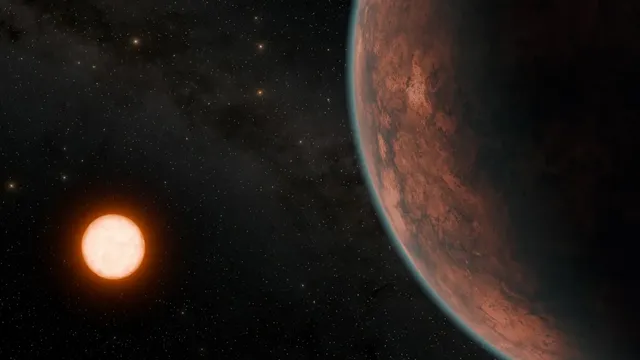Scientists have discovered a theoretically habitable, Earth-size planet

Two teams of scientists have discovered a theoretically habitable planet, smaller than Earth but bigger than Venus, orbiting a small star about 40 light-years away.
The exoplanet, named Gliese 12b, orbits a cool red dwarf star situated in the constellation Pisces and is about 27% the size of our sun and 60% of its temperature, according to the two studies published on Thursday in The Astrophysical Journal Letters and Monthly Notices of the Royal Astronomical Society.
Since its star is so much smaller than the sun, Gliese 12b still falls within the habitable zone — the ideal distance away from a star where liquid water can exist — even though it completes its orbit every 12.8 days.
Working on the assumption that the exoplanet doesn’t have an atmosphere, scientists calculated its surface temperature to be around 107 degrees Fahrenheit (42 degrees Celsius).
“We’ve found the nearest, transiting, temperate, Earth-size world located to date,” said Masayuki Kuzuhara, a project assistant professor at the Astrobiology Center in Tokyo and co-leader of one of the research teams with Akihiko Fukui, a project assistant professor at the University of Tokyo, in a statement.
For the first time, potential signs of the rainbow-like âglory effectâ have been detected on a planet outside our Solar System. Glory are colourful concentric rings of light that occur only under peculiar conditions.
Data from ESAâs sensitive Characterising ExOplanet Satellite, Cheops, along with several other ESA and NASA missions, suggest this delicate phenomenon is beaming straight at Earth from the hellish atmosphere of ultra-hot gas giant WASP-76b, 637 light-years away.
Related article
Scientists spot ‘glory effect’ on a world beyond our solar system for the first time
Once temperate Earth-size planets have been identified, scientists can then analyze them to determine which elements are contained in their atmospheres and, crucially, whether water is present to sustain life.
“There’s only a handful (of exoplanets) we’ve found that are good candidates for that. And this is our nearest and so that’s quite a major discovery,” Larissa Palethorpe, a doctoral student at the University of Edinburgh and University College London who co-led the other study, told CNN on Friday.
Understanding Gliese 12b
To spot Gliese 12b, scientists used the publicly available data collected by NASA’s Transiting Exoplanet Survey Satellite (TESS) — a telescope that stares at tens of thousands of stars every month, tracking their changes in brightness, which can be evidence of orbiting exoplanets.
It is easier for astronomers to find exoplanets orbiting red dwarf stars since their relatively small size results in a greater dimming effect during each transit.
At the moment, scientists are unsure exactly what constitutes this planet’s atmosphere, whether it even has one and if water is present, though Palethorpe said they aren’t expecting to find water there.
NASA's Voyager 2 spacecraft captured these views of Uranus (on the left) and Neptune (on the right) during its flybys of the planets in the 1980s.
Related article
Astronomers discover 3 previously unknown moons orbiting planets in our solar system
“There could be no water, and then we know a runaway greenhouse effect has already happened on this planet and it’s more like Venus,” she said. “There could be water, in which case it’s more like us… or there are signatures that can be detectable that would be able to show you that the runaway greenhouse effect is in progress so it could be losing water.”
For the next stage of analyzing the exoplanet’s atmosphere, scientists are hoping to use the James Webb Space Telescope and conduct spectroscopy analysis. This method involves capturing starlight that shines through an exoplanet’s atmosphere and seeing which wavelengths are absorbed by certain molecules, revealing their presence in the atmosphere.
As well as shedding light on the exoplanet itself, Palethorpe said scientists are hoping that this work can help us understand our own planet better.
“What this planet will teach us in particular is what happened for Earth to stay habitable but for Venus to not… It can tell us the habitability patheways that planets take as they develop,” she said.
But though the exoplanet could potentially be habitable for humans and is relatively “near” our solar system in astronomical terms, it is unlikely that anyone will visit there soon.
“It’s not reachable, it’s 12 parsecs away,” said Palethorpe, adding that it would take about 225,000 years to reach Gliese 12b with the fastest spacecraft that currently exist.
Up next
Is there a hidden planet in our solar system? Astronomers say the moment of truth is near
11 minute read
NASA launches mission to investigate a potentially habitable ocean world
7 minute read
What life is like in one of the most remote places on Earth
5 minute read
The planet’s largest lake is shrinking fast. Experts fear it may never recover
6 minute read
Find your solar fit with one of the best solar panel companies of 2024
10 minute read
Most read
More than 78 million ballots have been cast early this year. Here are 3 takeaways from pre-election voting
Harris and Trump tie in Dixville Notch midnight vote to kick off Election Day
Trump is a convicted felon. Here’s why he can still vote today
An hour-by-hour guide to election night poll closings
Joe Rogan endorses Trump on eve of the election
Russia suspected of sending incendiary devices on US- and Canada-bound planes, Wall Street Journal reports
How Donald Trump is laying the groundwork to dispute the election results – again
After their son came out, this conservative Christian couple went into a closet of their own
Ben Affleck had this to say about his ex, Jennifer Lopez
Why these are the five (or six) states to watch on election night